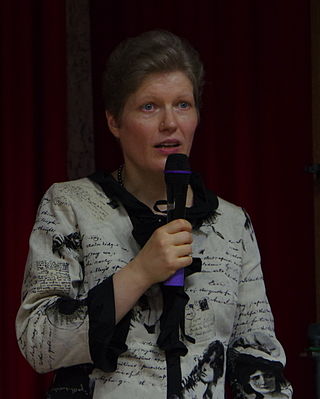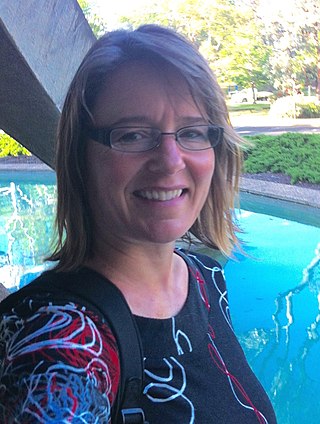Related Research Articles

Sandra Moore Faber is an American astrophysicist known for her research on the evolution of galaxies. She is the University Professor of Astronomy and Astrophysics at the University of California, Santa Cruz, and works at the Lick Observatory. She has made discoveries linking the brightness of galaxies to the speed of stars within them and was the co-discoverer of the Faber–Jackson relation. Faber was also instrumental in designing the Keck telescopes in Hawaii.
Annette Mairi Nelson Ferguson FRSE is a Scottish observational astrophysicist who specialises in the area of galaxy evolution. She is a professor at the Institute for Astronomy, Edinburgh, and holds the Personal Chair in Observational Astrophysics at the School of Physics and Astronomy, University of Edinburgh.
Amy J. Barger is an American astronomer and Henrietta Leavitt Professor of Astronomy at the University of Wisconsin–Madison. She is considered a pioneer in combining data from multiple telescopes to monitor multiple wavelengths and in discovering distant galaxies and supermassive black holes, which are outside of the visible spectrum. Barger is an active member of the International Astronomical Union.

Eva K. Grebel is a German astronomer. Since 2007 she has been co-director of the Astronomisches Rechen-Institut at the University of Heidelberg in Germany. Eva Grebel is an expert in the study of stellar populations and galaxy formation.

Priyamvada (Priya) Natarajan is a theoretical astrophysicist and professor in the departments of astronomy and physics at Yale University. She is noted for her work in mapping dark matter and dark energy, particularly in gravitational lensing and in models describing the assembly and accretion histories of supermassive black holes. She authored the book Mapping the Heavens: The Radical Scientific Ideas That Reveal the Cosmos.

Belinda Jane Wilkes is a Senior Astrophysicist at the Smithsonian Astrophysical Observatory (SAO) in Cambridge, Massachusetts, US, and former director of the Chandra X-ray Center.

Claudia Megan Urry is an American astrophysicist, who has served as the President of the American Astronomical Society, as chair of the Department of Physics at Yale University, and as part of the Hubble Space Telescope faculty. She is currently the Israel Munson Professor of Physics and Astronomy at Yale University and Director of the Yale Center for Astronomy and Astrophysics. Urry is notable not only for her contributions to astronomy and astrophysics, including work on black holes and multiwavelength surveys, but also for her work addressing sexism and sex equality in astronomy, science, and academia more generally.
Judith Gamora Cohen, is an American astronomer and the Kate Van Nuys Page Professor of Astronomy at the California Institute of Technology. She is a recognized expert regarding the Milky Way Galaxy, particularly with respect to the Galaxy's outer halo. She also played a key role in the design and construction of the Keck Telescope.
Emily Levesque is an American astronomer, author, and associate professor in the Department of Astronomy at the University of Washington. She is renowned for her work on massive stars and using these stars to investigate galaxy formation. She is also the author of three books, including the 2020 popular science book The Last Stargazers: The Enduring Story of Astronomy's Vanishing Explorers.

Burçin Mutlu-Pakdil is a Turkish-American astrophysicist, and Assistant Professor at Dartmouth College. She formerly served as a National Science Foundation (NSF) and Kavli Institute for Cosmological Physics (KICP) Postdoctoral Fellow at the University of Chicago. Her research led to a discovery of an extremely rare galaxy with a unique double-ringed elliptical structure, which is now commonly referred to as Burcin's Galaxy. She was also a 2018 TED Fellow, and a 2020 TED Senior Fellow.

Marcia Jean Rieke is an American astronomer. She is a Regents' Professor of Astronomy and associate department head at the University of Arizona. Rieke is the Principal Investigator on the near-infrared camera (NIRCam) for the James Webb Space Telescope (JWST). She has also served as the deputy-Principal Investigator on the Near Infrared Camera and Multi-Object Spectrometer (NICMOS) for the Hubble Space Telescope (HST), and as the co-investigator for the multiband imaging photometer on the Spitzer Space Telescope, where she also acted as an outreach coordinator and a member of the Science Working Group. Rieke was also involved with several infrared ground-based observatories, including the MMT Observatory in Arizona. She was vice chair for Program Prioritization of the Astro2010 Decadal Survey Committee, "New Worlds, New Horizons". Marcia Rieke is considered by many to be one of the "founding mothers" of infrared astronomy, along with Judith Pipher.

Kim A. Venn is a professor of physics and astronomy at the University of Victoria, Canada, and director of the university's Astronomy Research Centre. She researches the chemo-dynamical analysis of stars in the galaxy and its nearby dwarf satellites.
Ann I. Zabludoff is an American astronomer and astrophysicist whose research has included galaxy clusters and the effects of galactic environments on star formation, and the use of gravitational lenses to study the formation and interaction of the earliest galaxies, including observations with the Magellan Telescopes and Hubble Space Telescope. She is a professor of astronomy, astrophysics, and cosmology at the University of Arizona.
Alyson Brooks is an American theoretical astrophysicist and professor at Rutgers University. She uses large-scale simulations to determine how galaxies form.
Hsiao-Wen Chen is a Taiwanese-American astronomer who uses a combination of absorption spectroscopy and emission-line mapping to study diffuse baryonic "normal matter" in the intergalactic medium and galactic halos, and the connections between this matter and the matter in star-forming regions of galaxies. The circumgalactic medium resides in the interface between star-forming regions and intergalactic space contains the majority of baryonic mass as well as the critical record of gas circulation in and out of galaxies. Chen, a professor of astronomy and astrophysics at the University of Chicago, has been leading efforts to decipher how the growth and evolution of galaxies over cosmic time are connected and/or regulated by the physical properties of the circumgalactic gas.
Jacqueline K. (Jackie) Faherty is an American astronomer specializing in infrared astronomy and the observation of nearby stars and brown dwarfs, and known for her public outreach in space science. She works at the American Museum of Natural History as a senior scientist in the museum's Department of Astrophysics and a senior education manager in the Department of Education.
Caitlin M Casey is an observational astronomer and associate professor at the University of Texas at Austin. She is known for her work in extragalactic astrophysics where she works on the formation and evolution of galaxies.

Ata Sarajedini is an astrophysicist, professional astronomer, academic, author, and podcaster. He is the Bjorn Lamborn Endowed Chair and Professor in Astrophysics at Florida Atlantic University.
Yanqin Wu is a theoretical astrophysicist whose research concerns planet formation, protoplanetary disks, the effects on planets of photoevaporation, orbital resonance, and planetary migration, and the classification and distribution of exoplanets. She has theorized that planetary collisions have culled initially-crowded systems until what remains is often on the edge of chaos, and used oscillations in the rings of Saturn to study the past history of the Solar System. Educated in China and the US, she has worked in England and Canada, where she is a professor in the Department of Astronomy & Astrophysics of the University of Toronto.
Snežana Stanimirović ia a Serbian-American radio astronomer whose research focuses on the interstellar medium and intergalactic medium, including neutral hydrogen clouds and the production of cosmic dust by supernovae. She is a professor of astronomy at the University of Wisconsin–Madison.
References
- ↑ "Ten Young Geniuses Shaking Up Science Today", Popular Science, 20 October 2009, retrieved 2024-04-23
- 1 2 3 de los Reyes, Mia (6 June 2021), "Meet the AAS Keynote Speakers: Dr. Marla Geha", Astrobites, retrieved 2024-04-23
- ↑ "Marla Geha", Physics people, Yale University, retrieved 2024-04-23
- 1 2 3 4 5 Curriculum vitae, Yale University Astronomy, retrieved 2024-04-23
- ↑ Morris, Nate (6 February 2023), Rubicon’s Nate Morris Interviews Yale Astrophysicist Professor Marla Geha, Rubicon, retrieved 2024-04-23
- ↑ "Marla C Geha", AstroGen, American Astronomical Society, retrieved 2024-04-23
- ↑ ‘Million-Dollar Professor’ to build community of warrior-scholar scientists, Yale University Astronomy, 13 December 2017, retrieved 2024-04-23
- ↑ "Marla Geha", Fellows, John Simon Guggenheim Memorial Foundation, retrieved 2024-04-23